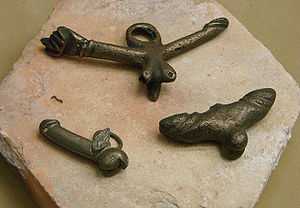Fascinus

In ancient Roman religion and magic, the fascinus or fascinum was the embodiment of the divine phallus. The word can refer to the deity himself (Fascinus), to phallus effigies and amulets, and to the spells used to invoke his divine protection.[1] Pliny calls it a medicus invidiae, a "doctor" or remedy for envy (invidia, a "looking upon") or the evil eye.
Public religion

The Vestal Virgins tended the cult of the fascinus populi Romani, the sacred image of the phallus that was one of the tokens of the safety of the state (sacra Romana). It was thus associated with the Palladium.[2] Roman myths, such as the begetting of Servius Tullius, suggest that this phallus was an embodiment of a masculine generative power located within the hearth, regarded as sacred.[3] When a general celebrated a triumph, the Vestals hung an effigy of the fascinus on the underside of his chariot to protect him from invidia.[4]
Augustine, whose primary source on Roman religion was the lost theological works of Varro, notes that a phallic image was carried in procession annually at the festival of Father Liber, the Roman god identified with Dionysus or Bacchus, for the purpose of protecting the fields from fascinatio, magic compulsion:[5]
| “ | Varro says that certain rites of Liber were celebrated in Italy which were of such unrestrained wickedness that the shameful parts of the male were worshipped at crossroads in his honour. … For, during the days of the festival of Liber, this obscene member, placed on a little trolley, was first exhibited with great honour at the crossroads in the countryside, and then conveyed into the city itself. … In this way, it seems, the god Liber was to be propitiated, in order to secure the growth of seeds and to repel enchantment (fascinatio) from the fields.[6] | ” |
As a divinized phallus, Fascinus shared attributes with Mutunus Tutunus, whose shrine was supposed to date from the founding of the city, and the imported Greek god Priapus.[7]
Magic symbols

A graphic representation of the power of the fascinus to ward off the evil eye is found on a Roman mosaic that depicts a phallus ejaculating into a disembodied eye.[8] The motif is also known from multiple relief sculptures from Leptis Magna in present-day Libya.[9] A 1st-century BC terracotta figurine shows "two little phallus-men sawing an eyeball in half."[10]
Phallic charms, often winged, were ubiquitous in Roman culture, from jewelry to bells and wind chimes to lamps.[11] The fascinus was thought particularly to ward off evil from children, mainly boys, and from conquering generals. Pliny notes the custom of hanging a phallic charm on a baby's neck, and examples have been found of phallus-bearing rings too small to be worn except by children.[12]

The "fist and phallus" amulet was prevalent amongst soldiers. These are phallic pendants with a representation of a (usually) clenched fist at the bottom of the shaft, facing away from the glans. Several examples show the fist making the manus fica or "fig sign", a symbol of good luck.[13] The largest known collection comes from Camulodunum.[14]
Etymology
The English word "fascinate" ultimately derives from Latin fascinum and the related verb fascinare, "to use the power of the fascinus," that is, "to practice magic" and hence "to enchant, bewitch." Catullus uses the verb at the end of Carmen 7, a hendecasyllabic poem addressing his lover Lesbia; he expresses his infinite desire for kisses that cannot be counted by voyeurs nor "fascinated" (put under a spell) by a malicious tongue; such bliss, as also in Carmen 5, potentially attracts invidia.[15]
Fescennine verses, the satiric and often lewd songs or chants performed on various social occasions, may have been so-named from the fascinum; ancient sources propose this etymology along with an alternative origin from Fescennia, a small town in Etruria.[16]
References

- ↑ The neuter form fascinum is used most often for objects or magic charms, masculine fascinus for the god.
- ↑ R. Joy Littlewood, A Commentary on Ovid: Fasti Book 6 (Oxford University Press, 2006), p. 73; T.P. Wiseman, Remus: A Roman Myth (Cambridge University Press, 1995), p. 61 online.
- ↑ Joseph Rykwert, The Idea of a Town: The Anthropology of Urban Form in Rome, Italy, and the Ancient World (MIT Press, 1988), pp. 101 and 159 online.
- ↑ Pliny, Natural History 28.4.7 (28.39).
- ↑ Augustine of Hippo, De civitate Dei 7.21; Williams, Roman Homosexuality, p. 92.
- ↑ English translation by R.W. Dyson, Augustine: The City of God against the Pagans (Cambridge University Press, 1998, 2002), p. 292 online.
- ↑ Arnobius, Adversus nationes 4.7, explicity connects Tutunus to the fascinus; see Robert E.A. Palmer, "Mutinus Titinus: A Study in Etrusco-Roman Religion and Topography," in Roman Religion and Roman Empire: Five Essays (University of Pennsylvania Press, 1974), pp. 187–206.
- ↑ Daniel Ogden, Magic, Witchcraft, and Ghosts in the Greek and Roman Worlds: A Sourcebook (Oxford University Press, 2002), p. 25 online.
- ↑ Catherine Johns, Sex or Symbol? Erotic Images of Greece and Rome (Routledge, 1982), p. iv;Rediscovering Pompeii («L'Erma» di Bretschneider, 1990), p. 147.
- ↑ Craig Arthur Williams, Roman Homosexuality: Ideologies of Masculinity in Classical Antiquity p. 92 online.
- ↑ Williams, Roman Homosexuality, p. 92.
- ↑ Martin Henig, Religion in Roman Britain (London: BT Batsford LTD, 1984), pp. 185–186 online, with image of example.
- ↑ Henig, Religion in Roman Britain, p. 176; Portable Antiquities Scheme, cat num: LIN-2BE126, http://finds.org.uk/database/search/results/q/LIN-2BE126
- ↑ N. Crummy, Colchester Archaeological Report 2: The Roman Small finds from excavations in Colchester 1971-9 (Colchester: Colchester Archaeological Trust LTD, 1983).
- ↑ David Wray, Catullus and the Poetics of Roman Manhood (Cambridge University Press, 2001), p. 152 online.
- ↑ Gian Biagio Conte, Latin Literature: A History (Johns Hopkins University Press, 1987, 1994), p. 23 online.
External links
| Wikimedia Commons has media related to Fascinum. |